#also anon I'm 100% stealing “circley levels of hell” and calling this that from now on <3< /div>
Explore tagged Tumblr posts
Note
would u ever explain the circley levels of hell chapter/plot/theme structure bc i am very curious 👀👀👀
WELL NOW THAT I'VE FINISHED MY DEGREE!! yes absolutely!
I'll make a video explaining this too since it might be helpful to hear me explain it with... my face, but this circular story structure is something I'm calling orbital plot structure. Luckily for all of us, I wrote up a detailed memo for my workshop which I'll share below (with lots of expansion)!
Disclaimer: The following is all my original writing theory AKA I came up with all of this myself AKA this method is in early development. You're welcome to share it/use it wherever, just link back to me! This also means when I think more, there may be more to say, LOL.
TL;DR: the orbital plot structure consists of two elements: the thematic satellite and the "scene" rings that orbit the satellite. I've shared two versions (the original and the modified version) below!
Orbital plot structure
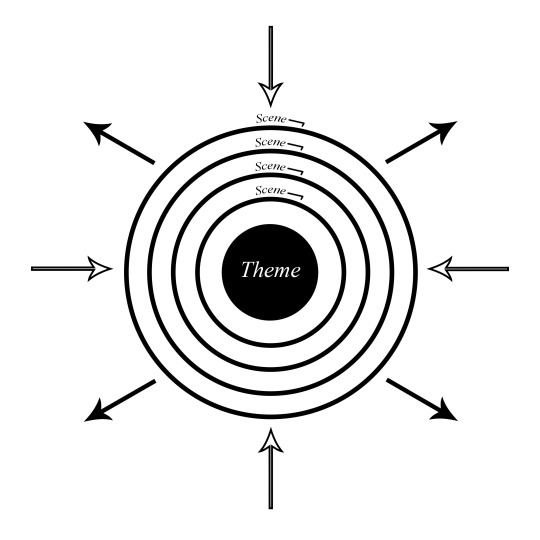
The orbital plot structure consists of two essential components: the thematic satellite and the scene rings. We have a core theme (the “satellite”) that every single scene “orbits” around. Every scene links back to the theme.
Plot progression/movement comes from the rings rippling outward (indicated by the outward pointing arrows). However, this movement is still deeply connected to the theme (indicated by the unfilled arrows pointed inward—we are pushed out by the theme like an exhale but naturally brought back toward the theme like an inhale). The amount of rings will differ for each work.
This plot structure may work well for theme-driven stories and chapters between 1500-3500 words.
Example:
Below is an example of the classic orbital plot structure for the first chapter of my novella, BODY BACK (chapter update HERE!). That chapter is called "Living Pictures."
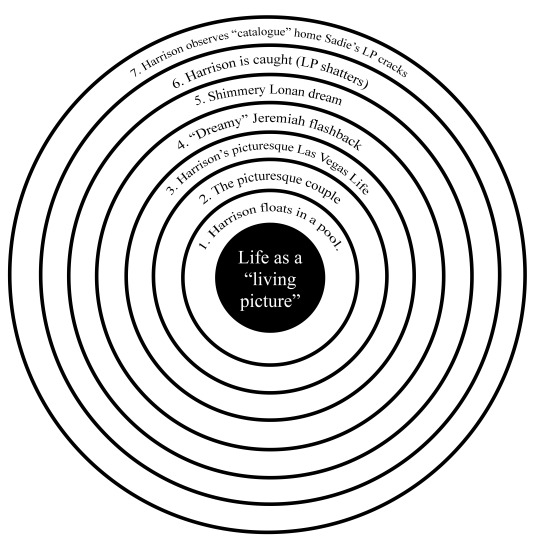
The theme for this chapter of course is "life as a living picture." Every single scene is necessitated by this theme and therefore precipitates the next scene that is also necessitated by the theme.
Here is a breakdown of how each scene links back to that theme:
Scene 1:
Harrison floats fully-clothed in a pool that belongs to a wealthy couple. He is jaded and also thinking about God
Explanation: This scene quite literally IS a living picture. Harrison feels unreal/otherworldly and not like an actual human person.
Scene 2:
Harrison describes the couple who own the house/pool. The man is a realtor, and the woman stays at home mostly, but walks dogs on the side.
Explanation: Harrison projects the couple who owns this home into "living picture" mode. He doesn't see them as people, but merely as The Realtor and The Dog-Walker.
Scene 3:
Harrison contemplates his “easy” Las Vegas life since moving in with his mother, Suzanna.
Explanation: Harrison explains how HIS actual life in Las Vegas has felt like a living picture (he also resists this idea at the end).
Scene 4:
Flashback: Harrison recalls drawing his new sort-of boyfriend, Jeremiah.
Explanation: This flashback with Jeremiah is ALSO a living picture. Heightened language. Dreamy imagery. He doesn't feel present, but like a snapshot in a moment.
Scene 5:
Harrison describes his vices (smoking and his ex, Lonan lmao, comparable) which trickles into a recurring dream/nightmare of Lonan.
Explanation: This scene is AGAIN a living picture--more dreamy language (it's quite literally a dream too). Lonan is captured in this memory, even though this moment was once real and not a photo.
Scene 6:
Distracted by the dream, Harrison is caught by the couple. The man seems unimpressed by him, though the woman (Sadie), perhaps realizing how young he is, invites him inside for tea.
Explanation: We SHATTER the living picture (LP) here. Harrison isn't living in a dream state, he's actually very much in the real world where breaking into a stranger's pool is NOT okay. LOL.
Scene 7:
Harrison observes the couple’s “catalogue” home while Sadie makes tea.
Explanation: Sadie and her husband live in a home that is also picturesque. BUT, he quickly notices something is amiss--she doesn't actually seem to genuinely exist in its pristineness and niceties, just like Harrison doesn't exist in the niceties of his "new" life in Las Vegas. This is why I ended the chapter here--he's addressed the theme.
You'll notice I didn't include the arrows in the above diagram--I've only included those for demonstration purposes to show how movement in this type of structure works. You know how water ripples in a circular pattern when you drop a stone into it? That's how this story structure progresses--every scene revolves around that stone in the centre.
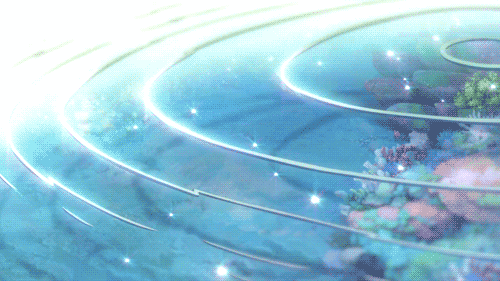
^^ A visual for you!
Typically, in western storytelling, we think of structure like this:
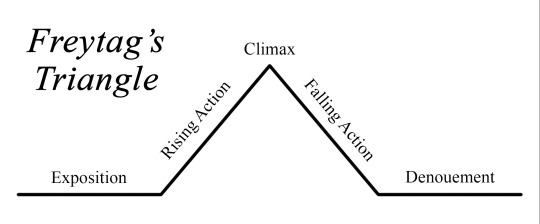
This diagram is known as Freytag's triangle/pyramid, and it's a useful way to understand stories (though... not my favourite for many reasons, but a great place to brainstorm your own writing theory). In diagrams like this, it's easier to see the movement of a story, since the line naturally moves left to right.
You could ABSOLUTELY map "Living Pictures" on the above structure, but I personally prefer the orbital plot structure for this particular series of books (Moth Work x Feeding Habits x BODY BACK) because of how deeply thematic they are. Because those projects are very internal and driven by complicated emotional exploration into central themes, it only made sense to map my own story structure that was reflective of that.
To clarify, I don't mean that other structures can't contain theme. Of course they can! But this plot structure is specifically built for thematically-driven work (this would NOT work if your work was not thematically-driven).
Funnily, the orbital plot structure is what my brain "sees" as I write chapters in this series (I don't follow this structure for every project). So while some people outline, brainstorm, etc, in advance of drafting, I start drafting with this in mind. Usually I don't figure out the theme until I'm through the first scene, or sometimes until I'm done the first draft, but when that theme is identified, it's very easy for me to either mould the rest of the chapter around the theme, or revise it around that theme.
If I'm stuck while drafting a chapter, it's usually because something about the theme isn't clear--consciously or subconsciously--to me.
Also: because of the nature of this structure being quite specific to a theme, this is probably not the best fit for very long works/chapters. But I'm sure you could try!
Speaking of longer works...
Orbital plot structure (modified)

The modified orbital plot structure follows the same principles of the orbital plot structure with two essential components: the thematic satellite and the scene rings. Scenes continue to orbit the “satellite.” However, a new element—fossae/dips—are introduced in the case of longer word counts (3500+).
The amount of rings and dips will differ depending on the project (there can be more or less than what is pictured above). These dips serve as scenes that may not be as closely related to the theme but that still move the work toward another thematic scene/“bump.”
Plot progression/movement comes from the rings rippling outward (indicated by the outward pointing arrows). However, this movement is still deeply connected to the theme (indicated by the unfilled arrows pointed inward—we are pushed out by the theme like an exhale but naturally brought back toward the theme like an inhale).
I'm not going to include a physical example of this because that would be... a teeny cumbersome, LOL, but this is just an option for people who like the orbital plot structure idea but don't feel like they want to write scenes that are extremely thematic every single time (or their work wouldn't fit that original model).
To note: The dips/bumps don't need to be uniform. Two dips can follow each other, just as three bumps could follow each other. This will depend on you and the work.
But good writers don't gatekeep <3 so here's a written version of chapter six of Feeding Habits that follows this structure quite nicely. For the sake of clarity, I'm going to call the fossae/dip scenes "dips" and the thematic scenes "bumps."
CW: Dead animals, blood, violence
THEME: Indissoluble bonds
Scene A:
DIP: Harrison gets back to the NYC apartment he shares with his mother after running errands to ward off either the spirit that haunts their walls or to rescue whatever is stuck in them. His mother preps for a dinner as Harrison has invited his old pal Reeve over.
Explanation: This scene MUST happen to get us to the following "bump," and that's because we get some critical exposition here: Harrison has had to go to a hardware store for supplies to cut open the drywall in his apartment as he and his mother can hear something in the walls, AND, Reeve is coming over for dinner at Harrison's request. We're not sure why.
Scene B:
BUMP: Harrison removes a litter of kittens from behind the drywall. One of the kittens is dead. Strangely, a German Shepherd puppy is also in the litter.
Explanation: What does it mean for Harrison to find a single dead kitten in a litter of live kittens? Does that kitten have a bond to its litter, despite now being gone?
Scene C:
DIP: Reeve appears in a glamorous blur and makes an interesting first impression on Suz who seems slightly stunned and endeared by her.
Explanation: We need this scene to get us to the next bump--this is Reeve's intro and also introduces the "bond" she'll later form with Suz. The entire chapter title, "Blood Sister," comes from the women's bond. What does it mean to feel connected to someone as if you had actually done a blood pact? And is that similar to the bond between the kittens? ...And the bond between Lonan and Harrison...?
Scene D:
BUMP (subtler): At dinner Reeve confronts Harrison about his “straight-edge” lifestyle since moving to NYC and he realizes her judgements about his life being monotonous are very true–he lacks purpose.
Explanation: This scene gets us to an important realization for Harrison: he feels like something is missing in his life. I wonder WHAT (the answer is Lonan lol).
Scene E:
BUMP: Harrison and his mother clear the dishes and Suzanna confronts him on the fact that he hasn’t told her that Reeve is in fact Lonan’s sister. Suz knows the boys’ relationship is complicated, and plays Devil’s advocate by outright asking Reeve how her brother is. Reeve, who hasn’t seen Lonan longer than Harrison, has assumed Lonan lives with them or is close by, and feels semi-betrayed that Harrison has kept his whereabouts a secret.
Explanation: This one is more explicit of a bump. Why hasn't Harrison told his mother Reeve's true identity? Is it because he's not ready to even think about Lonan who he still feels inextricably connected to??? Yes!
Scene F:
DIP & BUMP: Reeve and Harrison drive to a garden and he’s reminded of the event that lead to him and his mother’s return to the east. Harrison meets Winona outside a convenience store, the same woman Lonan meets in ch.6 of Moth Work. She takes him to her mansion where she’s hosting a party and introduces him to her husband. Harrison makes multiple bad decisions which you can probably figure out for yourself!
Explanation: This scene almost serves as both a dip AND bump as we slowly "dip" into exposition. But the relevance and "bump" of this scene becomes abundantly clear when we realize the woman Harrison follows home is the SAME woman Lonan follows him in Moth Work. Indissoluble bonds driving you to do the same thing?? LMAO I love them <3
Scene G:
BUMP: Harrison wakes up in Winona’s house and is confused to see her and her husband standing over his leather jacket. If we remember what happened in ch. 6 of Moth Work, Lonan gets beat up by Winona’s husband and has Harrison’s jacket & angel chain stolen. We can assume from this scene that Winona has a) recognized the jacket and b) chosen him to come back to her house for the purpose of also beating him up (which happens).
Explanation: Again, why do Harrison and Lonan make the SAME decisions and have the SAME thing happen to them? Is this because they have an indissoluble bond? That theme is actually dropped explicitly in this scene. (Also a tangent: in the MW version of this scene, Lonan loses the fight--black eye art is the aftermath of that--and therefore loses the jacket, but in FH, Harrison stumbles out of there with his jacket HAHA so he won. Lonan is a loser. <3)
Scene H:
BUMP: Reeve and Harrison jump a fence into a garden to give the dead kitten an unorthodox “water burial” in the garden’s fountain. Reeve confronts him on why no one has seemed to care about her whereabouts for the last year, and also suggests the only reason he wanted to see her now is because he misses Lonan. Harrison miserably drinks too much wine.
Explanation: In this scene, Harrison contemplates the indissoluble bond between the dead kitten and its litter--it's gone now, but was still a part of that collective, just like Lonan is gone now from his life but is still part of his collective. Harrison accepts that yes, he indeed still feels connected to Lonan, and actually, deeply misses Lonan (like the kittens--do they miss their sibling now that its gone?). He literally writes out Lonan's name in the snow as an expression of admittance to that truth (THAT'S GAY AS FUCK HARRISON, GAY AS FUCK).
Alright, I couldn't help myself, here's an illustration to show what that chapter looks like according to this structure. You can see I only used one ring because I don't have that many scenes. Now that I think of it, for this modified structure, a single ring would work well for one story/chapter (whereas in the original structure, one ring equals a scene), unless you have 60 million scenes (or you use act breaks within chapters). *High five!* we've made a development as I wrote this post.
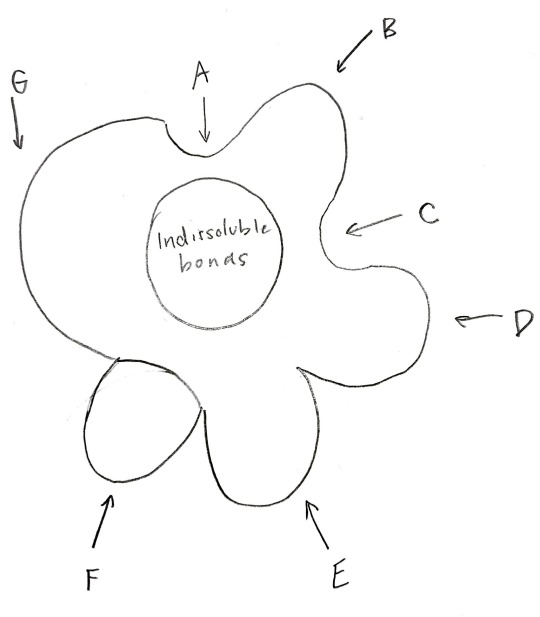
A hint about orbital structures: some crime TV shows use this structure IMO, ESPECIALLY episodes that follow crimes that are geared at revealing something about one of the central characters. Look at many of the Criminal Minds specials OR at any Hannibal episode and you won't be able to unsee it LOL.
Let me know if you have any questions! For writers who have very visual brains like me (or writers who've described their processes as "sculpting" words like myself), I hope this is useful!
#asks#writing#amwriting#writerblr#writeblr#this was FUN!!!#I love writing theory <3#not when it's written purposefully to be only accessible to academics tho <3#that writing theory can... go away LOL#so I'm HOPING this makes sense!#also anon I'm 100% stealing “circley levels of hell” and calling this that from now on <3#that's exactly what it is <3#also it's lowkey a crime that i so badly don't want to get my mfa due to the exclusivity of academia because#wouldn't i be slaying the literary world with all this CREATIVE and DETAILED writing theory#rip all the students i'll never have LMAO#BUT SIKE I HAVE ALL OF YOU <3
58 notes
·
View notes